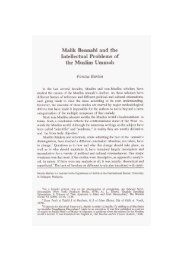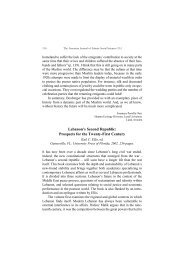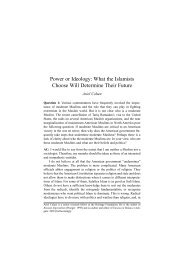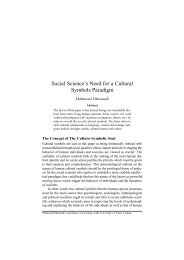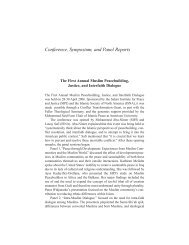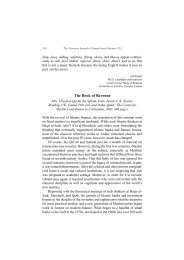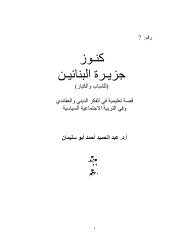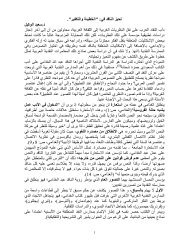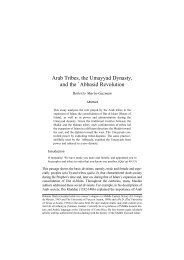The Chinese Sultanate: Islam, Ethnicity, and the ... - I-Epistemology
The Chinese Sultanate: Islam, Ethnicity, and the ... - I-Epistemology
The Chinese Sultanate: Islam, Ethnicity, and the ... - I-Epistemology
You also want an ePaper? Increase the reach of your titles
YUMPU automatically turns print PDFs into web optimized ePapers that Google loves.
110 <strong>The</strong> American Journal of <strong>Islam</strong>ic Social Sciences 23:3<br />
for food, l<strong>and</strong>, women, money, <strong>and</strong> power in a nineteenth-century Qing frontier<br />
area at a time when <strong>the</strong> central government was dysfunctional.<br />
This book is superb in explaining <strong>the</strong> Panthay rebellion. Atwill positions<br />
<strong>the</strong> violence in its ethnically, religiously, geographically, commercially, <strong>and</strong><br />
politically interwoven local context <strong>and</strong> thus avoids <strong>the</strong> reductionist <strong>and</strong> intuitional<br />
discourses often used to address violence in ethnic <strong>and</strong> cultural terms<br />
alone. He captures <strong>the</strong> tension between large-scale invading Han immigrants<br />
<strong>and</strong> local indigenous groups by tracing its trajectory <strong>and</strong> presenting patterns<br />
of historical violence between local ethnic groups <strong>and</strong> immigrant Hans. <strong>The</strong><br />
Panthay rebellion represents <strong>the</strong> zenith of this kind of violence, <strong>and</strong> Atwill<br />
identifies <strong>the</strong> social <strong>and</strong> materialistic roots for <strong>the</strong> Hans’ hatred <strong>and</strong> attempt to<br />
exterminate <strong>the</strong> Hui. Ano<strong>the</strong>r virtue of this book is Atwill’s juxtaposition of<br />
identity <strong>and</strong> violence, such as linking <strong>the</strong> Panthay rebellion to Muslim ethnic<br />
<strong>and</strong> religious identities during a time of crisis (pp. 155-60).<br />
<strong>The</strong> only question I have is, in addition to known Manchu-Han official<br />
prejudice toward <strong>the</strong> Hui in nineteenth-century Yunnan, what was <strong>the</strong> state’s<br />
degree of political complicity? Had <strong>the</strong> author focused more on <strong>the</strong> patterns<br />
<strong>and</strong> histories of administrations (e.g., <strong>the</strong> st<strong>and</strong>ard province-county style of<br />
interior regions, subprefecture [ting] mixed with administrations <strong>and</strong> regulations,<br />
<strong>and</strong> indigenous local autonomies), why <strong>the</strong> state categorized Yunnan’s<br />
subject populations of Yunnan into three (Han, Hui, <strong>and</strong> Yi), <strong>and</strong> why it tolerated<br />
<strong>the</strong> massacres, <strong>the</strong> Han policy of slaughtering <strong>the</strong> Hui would have<br />
been more comprehensible. I believe that categorizing Yunnan’s populations<br />
seems to be related to <strong>the</strong>se administrative trivia <strong>and</strong> <strong>the</strong> need to st<strong>and</strong>ardize<br />
those differences that allowed <strong>the</strong> state to tolerate such events.<br />
Administrative differences make sense to both Hui identity debates <strong>and</strong><br />
Han identity. Atwill carefully categorizes Huimin <strong>and</strong> Mumin, respectively,<br />
as “ethnic” (Hui) <strong>and</strong> “religious” (Muslim) identities (p. 157). <strong>The</strong>re is no<br />
problem with translating <strong>the</strong> latter as religious identity, for it is probably<br />
derived from <strong>the</strong> Arabic term mu’min (believer). However, his treatment <strong>and</strong><br />
reading of huimin as ethnic identity is problematic. Ma Rulong’s justification<br />
for surrendering, that “<strong>the</strong> state had treated its people (min) benevolently”<br />
(p. 156), seems to suggest that Huimin (Hui commoner) primarily<br />
expressed <strong>the</strong> person’s legal status as min (commoner), despite <strong>the</strong> culturalethnic<br />
modification (Hui). Interestingly enough, in contrast to Ma Rulong’s<br />
identification of <strong>the</strong> root of <strong>the</strong> Hui genocide with <strong>the</strong> Yunnan Han, Du<br />
Wenxiu attributed it to <strong>the</strong> alien Manchu ruler who refused to be a [Hui] min<br />
subject of <strong>the</strong> Qing <strong>and</strong> tried to establish a new regime for people of different<br />
cultures (jiaomin), among whom were <strong>the</strong> Mumin (Muslims).



